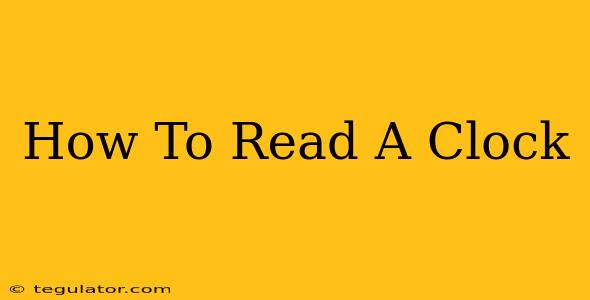Telling time might seem simple, but for beginners, understanding how a clock works can be a bit tricky. This comprehensive guide breaks down the process step-by-step, making it easy for anyone to learn. Whether you're teaching a child or brushing up on your own skills, this guide will equip you with the knowledge to confidently read any analog clock.
Understanding the Basics of Analog Clocks
Analog clocks, unlike digital clocks, use hands to display the time. There are three main hands:
- Hour Hand: This is the shortest hand and points to the hour.
- Minute Hand: This is the longer hand and points to the minutes.
- Second Hand: This is the longest hand and points to the seconds (some clocks omit this hand).
These hands move around the clock face, which is a circle divided into 12 sections, representing the 12 hours in a half-day. Each section is further divided into five smaller sections, representing the minutes.
Reading the Hour Hand
The hour hand tells you the hour. Look at where the shortest hand is pointing. If it's pointing directly at a number, that's the hour. For example, if the short hand points directly at the "3," it's 3 o'clock.
What if the hour hand is between two numbers?
If the hour hand is between two numbers, it means the hour has already started but hasn't yet reached the next full hour. For example, if the hour hand is between the "3" and the "4," it's sometime between 3 o'clock and 4 o'clock. You'll need the minute hand to determine the exact time.
Reading the Minute Hand
The minute hand is the longer hand. It moves around the clock face, completing a full circle in 60 minutes (one hour). Each small section on the clock face represents one minute.
Calculating the Minutes
To determine the minutes, count the number of small sections the minute hand has passed since the last full hour marker (the number). For example, if the minute hand points at the third small section after the "3," that represents 15 minutes past the hour (3 x 5 = 15 minutes).
Putting it All Together: Telling the Time
Now you can combine the information from the hour and minute hands to tell the exact time. Let's say the hour hand is between the "8" and "9," and the minute hand is pointing at the second small section after the "8." This means it's 8:10 (ten minutes past eight).
Practicing Your Skills
The best way to learn how to read a clock is through practice. Try looking at different clocks and practicing telling the time. You can also use online clock resources or apps that allow you to practice reading analog clocks. Consistent practice will help you master this essential skill quickly.
Beyond the Basics: Understanding AM and PM
Once you've mastered reading the hour and minute hands, you'll want to understand the difference between AM and PM.
- AM: Represents the time from midnight (12:00 AM) to noon (12:00 PM).
- PM: Represents the time from noon (12:00 PM) to midnight (12:00 AM).
Knowing whether it's AM or PM is crucial for clarity, especially when scheduling appointments or making plans.
Conclusion: Mastering the Art of Time-Telling
Learning to read a clock is a fundamental life skill. By understanding the role of each hand and practicing regularly, you can confidently tell the time on any analog clock. Remember, it's a skill that improves with practice, so keep practicing and soon you'll be a time-telling pro!

